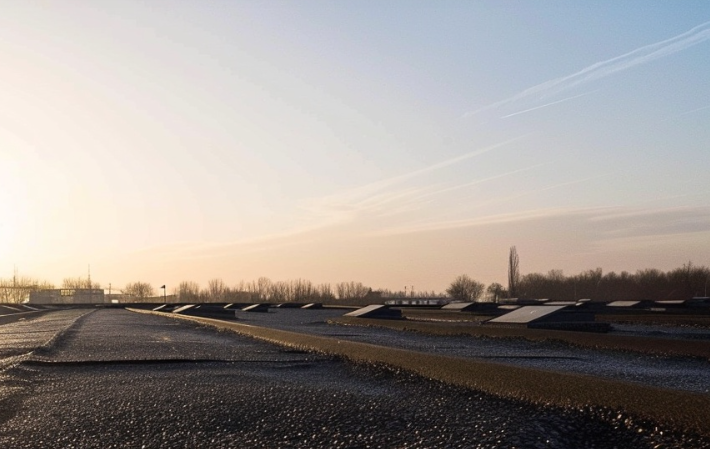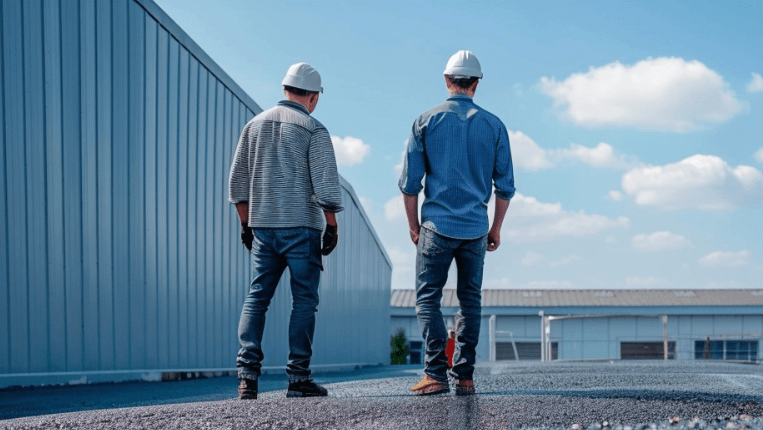
What is a Tar and Gravel Roof?
A tar and gravel roof, commonly referred to as a built-up roof (BUR), is a type of flat roofing system that consists of multiple layers. These layers include bitumen (tar), reinforcing fabrics, and a top layer of gravel or crushed stone. The bitumen provides waterproofing, while the reinforcing fabrics add strength and stability to the roof. The gravel layer protects the underlying materials from UV radiation, wind, and physical damage, extending the roof’s lifespan.
Tar and gravel roofs are highly effective at withstanding the elements, making them a popular choice for commercial buildings. The combination of materials provides excellent waterproofing and durability, which is why this roofing method has stood the test of time.
Installation Process
The installation of a tar and gravel roof is a meticulous process that involves several steps to ensure a durable and long-lasting roof. Here’s a step-by-step overview:
- Preparation: The roof deck must be clean, dry, and free of any debris. Any existing roofing material is removed to ensure a smooth surface for the new roof.
- Applying the Base Layer: A layer of bitumen is heated and applied to the roof deck. This layer serves as the base and adheres to the deck, creating a waterproof seal.
- Adding Reinforcing Fabrics: A reinforcing fabric, typically made of fiberglass or polyester, is embedded into the hot bitumen. This step is repeated multiple times to create several layers. Each layer of bitumen and fabric adds strength and thickness to the roof.
- Finishing with Gravel: The final step involves applying a layer of gravel or crushed stone on top of the bitumen layers. The gravel is embedded into the top layer of bitumen while it is still hot, creating a protective surface.
- Inspection and Quality Control: After the installation is complete, the roof is thoroughly inspected to ensure all layers are properly applied and there are no weak spots or defects.
This multi-layered approach provides a robust roofing system that can last for many years with proper maintenance. The gravel layer is particularly important as it protects the bitumen from the sun’s UV rays, which can cause the bitumen to deteriorate over time. Additionally, the gravel provides weight and stability, helping the roof withstand high winds and other weather-related challenges.
Common Issues with Tar and Gravel Roofs
While tar and gravel roofs offer many benefits, they are not without their challenges. Some of the common ones include:
- Structural Weight Concerns. One of the primary concerns with tar and gravel roofs is the added weight they place on the building’s structure. The multiple layers of bitumen and reinforcing fabrics, topped with gravel, can be quite heavy. This added weight requires a robust and well-designed support structure. Over time, the weight can cause stress on the building, potentially leading to structural issues if not properly addressed.
- Maintenance Challenges. Maintaining a tar and gravel roof can be more challenging compared to other roofing systems. The gravel layer can make it difficult to detect and repair leaks or other damage. Regular inspections are essential to identify problems early, but the gravel can obstruct a thorough examination. Additionally, repairs can be more complicated and time-consuming due to the multiple layers involved.
- Gravel Deterioration. Over time, the gravel layer can break down and become less effective. This deterioration can be caused by various factors, including weathering, foot traffic, and exposure to the elements. As the gravel degrades, its protective capabilities diminish, making the underlying bitumen more vulnerable to UV damage and environmental factors.
- Foot Traffic Damage. Commercial roofs often experience foot traffic from maintenance personnel or other activities. This traffic can displace the gravel, cause wear and tear on the bitumen layers, and potentially lead to punctures or other damage. It’s important to minimize unnecessary foot traffic and use protective walkways to reduce the risk of damage.
- Mold and Moisture Problems. Flat roofs, including tar and gravel roofs, are prone to water pooling, which can lead to mold and moisture issues. Poor drainage can exacerbate this problem, causing water to accumulate and seep into the layers of the roof. Over time, this moisture can lead to mold growth, which not only damages the roof but can also pose health risks to the building’s occupants.
Proper Maintenance and Coating

Maintaining a tar and gravel roof involves regular inspections, timely repairs, and protective coatings to extend its lifespan and functionality.
Best Practices for Coating
Applying a protective coating to a tar and gravel roof can help enhance its durability and resistance to the elements. Here are some best practices for coating:
- Choose the Right Coating Material: There are various coating materials available, such as acrylic, silicone, and elastomeric coatings. Select a material that suits your climate and roofing needs. For instance, silicone coatings are excellent for waterproofing and UV protection.
- Clean the Roof Surface: Before applying any coating, the roof surface must be thoroughly cleaned to remove dirt, debris, and loose gravel. This ensures better adhesion and effectiveness of the coating.
- Repair Any Damage: Inspect the roof for any existing damage, such as cracks, punctures, or loose gravel. Repair these issues before applying the coating to ensure a smooth and even application.
- Apply Evenly: Use a roller or sprayer to apply the coating evenly across the roof surface. Make sure to follow the manufacturer’s instructions regarding the thickness and number of coats required.
Regular Maintenance
Regular maintenance is key for the longevity of a tar and gravel roof. Here are some tips to keep your roof in top condition:
- Conduct Regular Inspections: Inspect the roof at least twice a year, especially after severe weather events. Look for signs of wear, damage, or gravel displacement.
- Clear Debris: Remove any debris, leaves, or branches that may accumulate on the roof.
- Check for Ponding Water: Ensure that the roof has proper drainage and there are no areas where water can pool. Address any drainage issues promptly to prevent moisture-related problems.
- Monitor Foot Traffic: Limit foot traffic on the roof and use protective walkways to minimize the risk of damage. Ensure that anyone accessing the roof is aware of the proper procedures to avoid causing harm.
Benefits of Using Gravel
UV Protection: The gravel layer shields the underlying bitumen from the sun’s ultraviolet (UV) rays. UV radiation can cause the bitumen to deteriorate and become brittle over time, leading to cracks and leaks. By protecting the bitumen, the gravel helps extend the lifespan of the roof and maintains its waterproofing capabilities.
Weight and Stability: Gravel adds weight to the roof, which helps hold the roofing materials in place. This is especially important in areas prone to high winds, where the added weight can prevent the roofing layers from being lifted or displaced. The gravel also helps distribute the weight evenly across the roof surface, reducing the risk of stress points and potential damage.
Impact Resistance: The gravel layer provides a protective barrier against physical damage. It can absorb the impact of falling debris, such as branches or hail, preventing punctures and other damage to the underlying bitumen.
Fire Resistance: Gravel has natural fire-resistant properties. In the event of a fire, the gravel layer can help slow the spread of flames and provide additional protection to the roofing materials beneath. This added layer of fire resistance can be particularly valuable for commercial buildings.
Thermal Insulation: Gravel contributes to the thermal insulation of the roof. It helps keep the building cooler in the summer by reflecting sunlight and reducing heat absorption. In the winter, the gravel layer helps retain heat, contributing to the overall energy efficiency of the building.
Drainage: Properly applied gravel can aid in roof drainage. It prevents water from pooling on the surface by allowing it to flow through the gravel layer to the roof drains. This helps reduce the risk of water-related damage, such as leaks and mold growth.
Need Help?
Tar and gravel roofs, or built-up roofs, offer a durable and cost-effective solution for flat and low-slope commercial buildings. Understanding the components and benefits of this roofing system can help you make informed decisions about installation, maintenance, and potential issues. That’s where Presidio Roofing comes in. Give us a call and we can answer all your questions!





